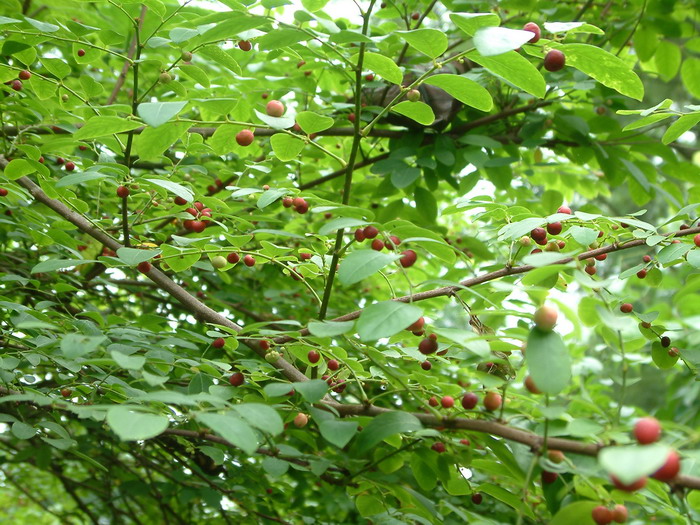红鱼眼Phyllanthus reticulatus
中文名(Chinese Name):红鱼眼
学名(Scientific Name):Phyllanthus reticulatus Poir.
英文名(English Common Name):
别名(Chinese Common Name):烂头钵、小果叶下珠
异名(Synonym):Phyllanthus reticulatus var. glaber Muell. Arg. Cicca reticulata (Poir.) Kurz Kirganelia multiflora (Willd.) Baill. Kirganelia reticulata (Poir.) Baill. Kirganelia sinensis Baill. Phyllanthus takaoensis Hayata Phyllanthus sinensis Müll. Arg. Phyllanthus microcarpus (Benth.) Müll. Arg. Cicca microcarpa Benth. Diasperus reticulatus (Poir.) Kuntze Anisonema reticulatum (Poir.) A.Juss.
科属(Family & Genus):大戟科(Euphorbiaceae)叶下珠属
形态特征(Description):灌木,高达4米;枝条淡褐色;幼枝、叶和花梗均被淡黄色短柔毛或微毛。叶片膜质至纸质,椭圆形、卵形至圆形,长1-5厘米,宽0.7-3厘米,顶端急尖、钝至圆,基部钝至圆,下面有时灰白色;叶脉通常两面明显,侧脉每边5-7条;叶柄长2-5 毫米;托叶钻状三角形,长达1.7毫米,干后变硬刺状,褐色。通常2-10朵雄花和1朵雌花簇生于叶腋,稀组成聚伞花序;雄花:直径约2毫米;花梗纤细,长5-10毫米;萼片5-6,2轮,卵形或倒卵形,不等大,长0.7-1.5毫米,宽0.5-1.2毫米,全缘;雄蕊5,直立,其中3枚较长,花丝合生,2枚较短而花丝离生,花药三角形,药室纵裂;花粉粒球形,具3沟孔;花盘腺体5,鳞片状,宽0.5毫米;雌花:花梗长4-8毫米,纤细;萼片5-6,2轮,不等大,宽卵形,长1-1.6毫米,宽0.9-1.2毫米,外面基部被微柔毛;花盘腺体5-6,长圆形或倒卵形;子房圆球形,4-12室,花柱分离,顶端2裂,裂片线形卷曲平贴于子房顶端。蒴果呈浆果状,球形或近球形,直径约6毫米,红色,干后灰黑色,不分裂,4-12室,每室有2颗种子;种子三棱形,长1.6-2毫米,褐色。染色体基数x=13。花期3-6月,果期6-10月。
分布(Distribution):产江西、福建、台湾、湖南、广东、海南、广西、四川、贵州和云南等省区,生于海拔200-800米山地林下或灌木丛中。广布于西非至印度、中南半岛至澳大利亚。
用途(Use):根、叶供药用:驳骨、跌打。
引自中国植物志英文版FOC Vol. 11 Page 164, 181, 183
Phyllanthus reticulatus Poiret in Lamark, Encycl. 5: 298. 1804.
小果叶下珠 xiao guo ye xia zhu | Euphorbiaceae | Phyllanthus
Cicca microcarpa Bentham ; C. reticulata (Poiret) Kurz; Glochidion microphyllum Ridley; Kirganelia multiflora Baillon; K. reticulata (Poiret) Baillon; K. sinensis Baillon; Phyllanthus dalbergioides Wallich ex J. J. Smith; P. erythrocarpus Ridley; P. microcarpus (Bentham) Müller Argoviensis; P. multiflorus Poiret; P. multiflorus Willdenow (1805), not Poiret (1804); P. reticulatus var. glaber Müller Argoviensis; P. sinensis Müller Argoviensis, nom. invalid, nom. nud. (Müll.Arg. merely cited "Kirganelia sinensis Baill." (invalid) as the basionym); P. takaoensis Hayata.
Shrubs to 4 m tall, monoecious; branches brownish; young branchlets, leaves, and pedicels yellowish pubescent or puberulent or glabrous. Stipules subulate-lanceolate, brown, 1-3 mm, hard and spiny when dry; petiole 2-5 mm; leaf blade varying in shape, mostly elliptic to ovate, 1-5(-6.5) × 0.7-3 cm, membranous to papery, base obtuse to rounded, apex acute or obtuse to rounded; lateral veins 5-7 pairs, usually prominent on both surfaces. Inflorescence an axillary fascicle, rarely a cyme, with 2-10 male and 1 or 2 female flowers. Male flowers: pedicels delicate, 5-10 mm; sepals 5 or 6, in 2 series, ovate or obovate, unequal, 0.7-1.5 × 0.5-1.2 mm, entire; disk glands 5, scalelike, ca. 0.5 mm wide; stamens 5, erect, 3 with longer filaments coherent in a central column, 2 with shorter filaments, free; anthers triangular, longitudinally dehiscent. Female flowers: pedicels 4-8 mm, delicate; sepals 5 or 6, in 2 series, unequal, broadly ovate, 1-1.6 × 0.9-1.2 mm, puberulent inside at base; disk glands 5 or 6, oblong or obovate; ovary 4-12-celled, smooth; styles free, bifid at apex, lobes linear, revolute and connivent over top of ovary. Fruit a berry, globose to oblate, 4-6 mm wide, black and dark purplish at maturity, 4-12-celled, 8-16-seeded. Seeds trigonous, 1.6-2 mm, brown. Fl. Mar-Jun, fr. Jun-Oct. x = 13.
Open forests, scrub; 200-800 m. Fujian, Guangdong, Guangxi, Guizhou, Hainan, Hunan, Jiangxi, Sichuan, Taiwan, Yunnan [Bhutan, Cambodia, India, Indonesia, Laos, Malaysia, Nepal, Philippines, Sri Lanka, Thailand, Vietnam; W Africa, NE Australia].
Glabrous plants have been recognized as var. glaber , but such forms occur sporadically throughout the range of the species and are of dubious taxonomic value.


(责任编辑:徐晔春)
学名(Scientific Name):Phyllanthus reticulatus Poir.
英文名(English Common Name):
别名(Chinese Common Name):烂头钵、小果叶下珠
异名(Synonym):Phyllanthus reticulatus var. glaber Muell. Arg. Cicca reticulata (Poir.) Kurz Kirganelia multiflora (Willd.) Baill. Kirganelia reticulata (Poir.) Baill. Kirganelia sinensis Baill. Phyllanthus takaoensis Hayata Phyllanthus sinensis Müll. Arg. Phyllanthus microcarpus (Benth.) Müll. Arg. Cicca microcarpa Benth. Diasperus reticulatus (Poir.) Kuntze Anisonema reticulatum (Poir.) A.Juss.
科属(Family & Genus):大戟科(Euphorbiaceae)叶下珠属
形态特征(Description):灌木,高达4米;枝条淡褐色;幼枝、叶和花梗均被淡黄色短柔毛或微毛。叶片膜质至纸质,椭圆形、卵形至圆形,长1-5厘米,宽0.7-3厘米,顶端急尖、钝至圆,基部钝至圆,下面有时灰白色;叶脉通常两面明显,侧脉每边5-7条;叶柄长2-5 毫米;托叶钻状三角形,长达1.7毫米,干后变硬刺状,褐色。通常2-10朵雄花和1朵雌花簇生于叶腋,稀组成聚伞花序;雄花:直径约2毫米;花梗纤细,长5-10毫米;萼片5-6,2轮,卵形或倒卵形,不等大,长0.7-1.5毫米,宽0.5-1.2毫米,全缘;雄蕊5,直立,其中3枚较长,花丝合生,2枚较短而花丝离生,花药三角形,药室纵裂;花粉粒球形,具3沟孔;花盘腺体5,鳞片状,宽0.5毫米;雌花:花梗长4-8毫米,纤细;萼片5-6,2轮,不等大,宽卵形,长1-1.6毫米,宽0.9-1.2毫米,外面基部被微柔毛;花盘腺体5-6,长圆形或倒卵形;子房圆球形,4-12室,花柱分离,顶端2裂,裂片线形卷曲平贴于子房顶端。蒴果呈浆果状,球形或近球形,直径约6毫米,红色,干后灰黑色,不分裂,4-12室,每室有2颗种子;种子三棱形,长1.6-2毫米,褐色。染色体基数x=13。花期3-6月,果期6-10月。
分布(Distribution):产江西、福建、台湾、湖南、广东、海南、广西、四川、贵州和云南等省区,生于海拔200-800米山地林下或灌木丛中。广布于西非至印度、中南半岛至澳大利亚。
用途(Use):根、叶供药用:驳骨、跌打。
引自中国植物志英文版FOC Vol. 11 Page 164, 181, 183
Phyllanthus reticulatus Poiret in Lamark, Encycl. 5: 298. 1804.
小果叶下珠 xiao guo ye xia zhu | Euphorbiaceae | Phyllanthus
Cicca microcarpa Bentham ; C. reticulata (Poiret) Kurz; Glochidion microphyllum Ridley; Kirganelia multiflora Baillon; K. reticulata (Poiret) Baillon; K. sinensis Baillon; Phyllanthus dalbergioides Wallich ex J. J. Smith; P. erythrocarpus Ridley; P. microcarpus (Bentham) Müller Argoviensis; P. multiflorus Poiret; P. multiflorus Willdenow (1805), not Poiret (1804); P. reticulatus var. glaber Müller Argoviensis; P. sinensis Müller Argoviensis, nom. invalid, nom. nud. (Müll.Arg. merely cited "Kirganelia sinensis Baill." (invalid) as the basionym); P. takaoensis Hayata.
Shrubs to 4 m tall, monoecious; branches brownish; young branchlets, leaves, and pedicels yellowish pubescent or puberulent or glabrous. Stipules subulate-lanceolate, brown, 1-3 mm, hard and spiny when dry; petiole 2-5 mm; leaf blade varying in shape, mostly elliptic to ovate, 1-5(-6.5) × 0.7-3 cm, membranous to papery, base obtuse to rounded, apex acute or obtuse to rounded; lateral veins 5-7 pairs, usually prominent on both surfaces. Inflorescence an axillary fascicle, rarely a cyme, with 2-10 male and 1 or 2 female flowers. Male flowers: pedicels delicate, 5-10 mm; sepals 5 or 6, in 2 series, ovate or obovate, unequal, 0.7-1.5 × 0.5-1.2 mm, entire; disk glands 5, scalelike, ca. 0.5 mm wide; stamens 5, erect, 3 with longer filaments coherent in a central column, 2 with shorter filaments, free; anthers triangular, longitudinally dehiscent. Female flowers: pedicels 4-8 mm, delicate; sepals 5 or 6, in 2 series, unequal, broadly ovate, 1-1.6 × 0.9-1.2 mm, puberulent inside at base; disk glands 5 or 6, oblong or obovate; ovary 4-12-celled, smooth; styles free, bifid at apex, lobes linear, revolute and connivent over top of ovary. Fruit a berry, globose to oblate, 4-6 mm wide, black and dark purplish at maturity, 4-12-celled, 8-16-seeded. Seeds trigonous, 1.6-2 mm, brown. Fl. Mar-Jun, fr. Jun-Oct. x = 13.
Open forests, scrub; 200-800 m. Fujian, Guangdong, Guangxi, Guizhou, Hainan, Hunan, Jiangxi, Sichuan, Taiwan, Yunnan [Bhutan, Cambodia, India, Indonesia, Laos, Malaysia, Nepal, Philippines, Sri Lanka, Thailand, Vietnam; W Africa, NE Australia].
Glabrous plants have been recognized as var. glaber , but such forms occur sporadically throughout the range of the species and are of dubious taxonomic value.
(责任编辑:徐晔春)
踩一下[0]

顶一下[2]